
VOICES, is a forum that highlights the expertise of those who make up and support the organization. WFPG members and partners are invited to submit blog posts on international affairs and foreign policy topics, women's leadership, and career advancement. Posts represent the reflections and personal views of members and guest bloggers and not those of their employers or of the WFPG. Interested in submitting a post? Guidelines | Membership
 
When the world went virtual in March 2020, the Women’s Foreign Policy Group looked for new ways to amplify the voices of women in foreign policy and to highlight their work. With this in mind, the WFPG launched a weekly What We’re Watching newsletter to share foreign policy focused discussions, podcasts and articles featuring women speakers and authors with its network and the wider foreign policy community. As a WFPG intern, I was able to contribute to this publication and to this incredibly important mission.
Searching for and curating these events and articles gave me an opportunity to see the amazing women working in the field of international relations--many of whom I may not have heard of or read about otherwise. By looking through each newsletter, one can also see which organizations and think tanks make gender parity a priority, and which do not. More importantly, however, curating information for the newsletter also gave me insight into the spaces in which women’s voices were not very well represented. The discrepancies in gender representation, most especially in the podcast realm, were disturbingly clear and I was surprised at how difficult it was to find content by women on certain issues.
Working on the WFPG’s What We’re Watching was an astonishingly eye-opening experience, and was one of the most rewarding parts of my internship. It taught me that we all need to be more conscious about the media that we consume. We need to ask why we’re not seeing more women in international story bylines and at major think tanks--and what we should be doing to shift the balance. I am proud to have contributed to highlighting women’s voices in foreign policy through my work on this publication and I hope that initiatives like this will continue to encourage organizations to reevaluate their programming and will help to make the case that change is needed.
Read WFPG's “What We're Watching: 2020 Year in Review”.
Janie Goheen is a senior at American University majoring in International Relations with a focus on global economics who interned at the WFPG from September to December 2020.
Return to top
 
Multilateral diplomacy has become all the more challenging because of limitations to in-person meetings due to the COVID-19 pandemic. This is particularly unfortunate as the most pressing challenges of the day, like pandemics and climate change, require cross-border, multilateral solutions. Here, we share three tips to better navigate the multilateral arena during the era of zoom diplomacy.
Establish virtual networks to provide up-to-date information on your issues/portfolio AND the space to test new ideas. In-person meetings at the UN and other multilateral organizations are useful not just because they allow interpersonal dynamics to play out, but also because they allow diplomats the opportunity to conduct essential “corridor diplomacy.” Through chats on meeting margins, diplomats can quickly gather intelligence to both inform policy making and avert potential blow ups. Corridor space is also a venue to test creative solutions to move discussions forward. To compensate for this lack of corridor diplomacy, we – and other diplomats - have created or plugged into virtual networks. Our Whatsapp group combining two different regional groups sends us the latest news on specific subjects and offers a sense of countries’ reactions. A weekly group call among 5-7 contacts with diverse negotiating positions has been a useful space to test ideas and launch COVID-19-related initiatives. An ongoing email chain within a group of female colleagues from different countries enables collective, seamless sharing of information on how our various offices are responding to COVID restrictions in real time, so that we can adapt quickly to the evolving situation.
Try to meet new negotiation counterparts one-on-one (even virtually!) before negotiating in a virtual group space. Important precursors to any formal negotiation are the informal exchanges that take place as negotiators enter the room to find their seats. These interactions allow negotiators to meet, get to know each other, and “warm up” for the ensuing conversation. Unlike in-person negotiations, it is impossible via online platforms to cross the room to make introductions or engage in chatter to build rapport before launching into negotiations. One of us recently learned the importance of this the hard way. As the lead negotiator for her delegation, she logged into the virtual negotiating room to find several counterparts from other delegations already present, but silent. After spending a few minutes trying to warm up the “room” through social conversation, she quickly realized that virtual chit chat works best with counterparts who already know each other; new colleagues were not as comfortable engaging in this way, on screen, with unknown counterparts. If she had met with the new colleagues one-on-one ahead of the group meeting to establish a rapport, this would have helped the newcomers to feel more comfortable in the broader group setting, enabling a smoother negotiation. Subsequent meetings have benefited from her more individualized approach with new counter parts before each negotiation.
For virtual negotiations that are likely to be divisive, plan ahead and undertake extensive outreach. Navigating a negotiation with thorny issues or prickly counterparts is difficult under the best of circumstances; it becomes even harder with the restrictions imposed during a pandemic. A potentially divisive in-person negotiation requires some advance planning, plenty of personal engagement, and at least a little pre-positioning – virtual negotiations require even more effort. Whether you are a negotiator or the Chair of a negotiation process, try to anticipate the issues and reach out early to colleagues to discuss them one-on-one, present some potential options for resolution, and set the stage for an open and collaborative discussion. In one recent virtual negotiation on a sensitive subject, the Chair of the discussion ensured a successful outcome with her thoughtful planning and early action. She logged into the online platform 30 minutes early so that she could welcome each negotiator individually as they logged in, fostering an atmosphere of inclusion and engendering goodwill. Prior to the session, the Chair had called individual negotiators to get a sense of their interests and priorities, which helped her set the stage for the discussion and manage ensuing conflicts. She also used phone calls to test out possible solutions she might table, helping her to find options for compromise and creative resolution. In a virtual world, there may be fewer opportunities for spontaneous collaboration, so a successful outcome requires even more purposeful (virtual) engagement in advance.
While these virtual settings may never replace in-person meetings, using the techniques described above can at least help prevent the worst scenarios and at best achieve a fruitful outcome - at a time when multilateralism is needed the most.
The authors co-authored “Negotiating at the United Nations” (Routledge, 2019) and negotiated together at the UN for years. They are all writing in their personal capacities.
A scientist turned diplomat, Dr. Rebecca E. Webber Gaudiosi represented the United States at the UN from 2006 – 2014. She was responsible for U.S. engagement with over twenty-five multilateral organizations working on environment and climate change and also led on sustainable development issues at the UNGA, including Rio+20.
From 2009 to 2015, Jimena Leiva-Roesch was at the Permanent Mission of Guatemala to the UN in New York. She was the lead negotiator on climate change and the Sustainable Development Goals (SDGs). Ms. Leiva-Roesch is currently a Senior Fellow with the International Peace Institute where she leads a global study on the implementation of the 2030 Agenda.
Ye-Min Wu has worked with the Ministry of Foreign Affairs, Singapore for over a decade. While at the Permanent Mission of Singapore to the UN, she chaired UN negotiations and represented the Group of 77 and China in negotiations on sustainable development. She is currently Singapore’s Deputy Permanent Representative to the WTO and WIPO.
Return to top
 
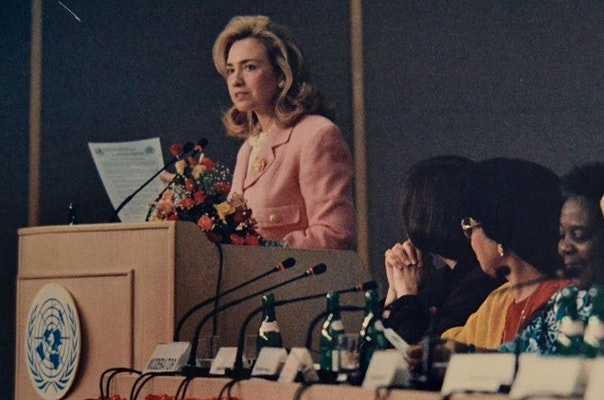 Twenty-five years ago, I stood in the plenary hall of the United Nations Fourth World Conference on Women in Beijing to hear then First Lady Hillary Rodham Clinton proclaim “Human Rights are Women’s Rights and Women’s Rights are Human Rights.” Twenty-five years ago, I stood in the plenary hall of the United Nations Fourth World Conference on Women in Beijing to hear then First Lady Hillary Rodham Clinton proclaim “Human Rights are Women’s Rights and Women’s Rights are Human Rights.”
As she described the injustices and acts of violence against women and girls around the world, the thousands of mostly female government delegates, from country after country, sprang to their feet, applauding as they heard one of the most powerful women in the world validate their struggles, whether it was against dowry burnings or rape as a tactic of war. These abuses and many others were being recognized for what they were, not cultural norms to be suffered in silence.
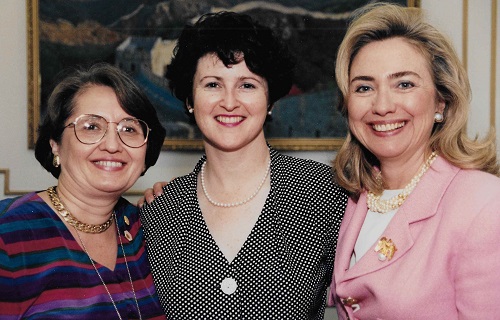 This was the kind of experience I could only dream about when I took the Foreign Service Exam. The emotion, energy, and determination in that electric moment inspired me and informed my career for years to come. This was the kind of experience I could only dream about when I took the Foreign Service Exam. The emotion, energy, and determination in that electric moment inspired me and informed my career for years to come.
Just eighteen months before the conference in Beijing, as a Foreign Service Officer at the US Department of State, my boss, Tim Wirth, then Under Secretary of State for Global Affairs, tapped me to set up a new office at State to prepare for a series of UN conferences, the largest being the United Nations Fourth World Conference on Women to be held in Beijing in September, 1995. There was intense national and international interest in the conference, which turned out to be the largest UN conference in history up to that point. More than 17,000 participants attended, including 6,000 delegates representing 189 governments, along with more than 4,000 accredited NGO representatives, a host of international civil servants, and some 4,000 media representatives. The conference document negotiated by the government delegates has served as a roadmap for women’s empowerment for the last 25 years. A parallel NGO Forum was held in the countryside in Huairou, far removed from the government delegates. The Forum drew 30,000 participants, including 7,000 participants from the US.
 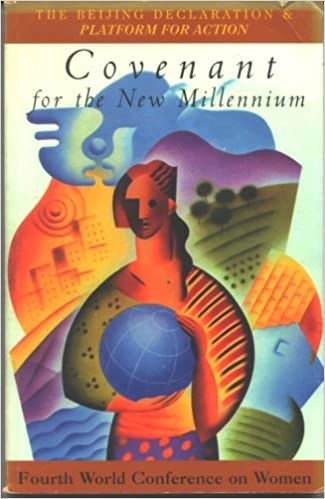 The US commitment to the UN Women’s Conference did not end in Beijing. Some months after returning home from Beijing, I was appointed as the Senior Coordinator for International Women’s Issues, a State Department position supported by Hillary Clinton and Madeleine Albright to encourage follow up to the UN Conference and to integrate women’s issues into US foreign policy. This role grew into the Ambassador-at-Large for Global Women’s Issues when Secretary of State Hillary Clinton appointed Melanne Verveer who played a leading role in the US participation in, and follow up to the UN Women’s Conference, followed by Cathy Russell who further grew the position. Both women have had a lasting impact on US foreign policy. I went from the State Department to cofound the Vital Voices Global Partnership along with a dynamic group of women including the next generation of leadership, Alyse Nelson who attended the Beijing conference as a college student and is now the Vital Voices President and CEO. Along the way, I partnered with the Women's Foreign Policy Group from its founder Patricia Ellis to its next generation of leadership Executive Director Kim Kahnhauser Freeman. Each of these women have a common commitment, to enlarge the circle of women’s leadership and support emerging leaders on their way up. Their efforts are taking root and making profound change. The US commitment to the UN Women’s Conference did not end in Beijing. Some months after returning home from Beijing, I was appointed as the Senior Coordinator for International Women’s Issues, a State Department position supported by Hillary Clinton and Madeleine Albright to encourage follow up to the UN Conference and to integrate women’s issues into US foreign policy. This role grew into the Ambassador-at-Large for Global Women’s Issues when Secretary of State Hillary Clinton appointed Melanne Verveer who played a leading role in the US participation in, and follow up to the UN Women’s Conference, followed by Cathy Russell who further grew the position. Both women have had a lasting impact on US foreign policy. I went from the State Department to cofound the Vital Voices Global Partnership along with a dynamic group of women including the next generation of leadership, Alyse Nelson who attended the Beijing conference as a college student and is now the Vital Voices President and CEO. Along the way, I partnered with the Women's Foreign Policy Group from its founder Patricia Ellis to its next generation of leadership Executive Director Kim Kahnhauser Freeman. Each of these women have a common commitment, to enlarge the circle of women’s leadership and support emerging leaders on their way up. Their efforts are taking root and making profound change.
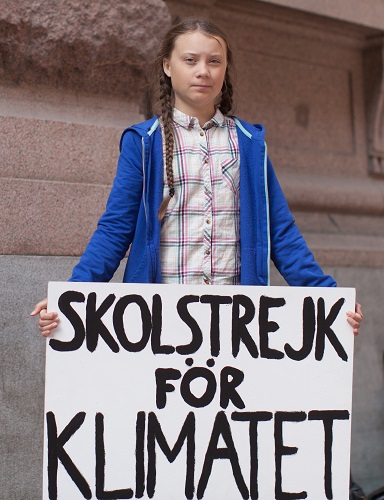  We see this intergenerational continuum of women’s leadership from Hillary Clinton’s clarion call at the UN Women’s Conference, to Malala Yousufzai’s defiance of the Taliban, to Greta Thunberg and Vanessa Nakate’s demands for action on climate change. So, wherever you are in your life journey, join in this unstoppable march of progress for women. Take the Foreign Service Exam, or take a leap and get into some other arena, and use your talents to work on big important issues. Bring other talented young women into the arena with you and make space for them when it’s their turn to lead. We still have so far to go. We see this intergenerational continuum of women’s leadership from Hillary Clinton’s clarion call at the UN Women’s Conference, to Malala Yousufzai’s defiance of the Taliban, to Greta Thunberg and Vanessa Nakate’s demands for action on climate change. So, wherever you are in your life journey, join in this unstoppable march of progress for women. Take the Foreign Service Exam, or take a leap and get into some other arena, and use your talents to work on big important issues. Bring other talented young women into the arena with you and make space for them when it’s their turn to lead. We still have so far to go.
Theresa Loar has been working at the nexus of business, human rights and diplomacy for over thirty years and is currently vice chair of the WFPG Board, a senior advisor for Business for Social Responsibility, and a lecturer at George Washington University’s Elliott School. @Theresa Loar
Photos: (1) Hillary Rodham Clinton speaking at United Nations Fourth World Conference on Women in Beijing on September 5, 1995 (2) Melanne Verveer, Theresa Loar, Hillary Clinton September 5, 1995 (3) Covenant for the New Millennium: The Beijing Declaration & Platform for Action. The final document negotiated by the conference delegates (4) The NGO Forum banner in Huairou, China (5) Greta Thunberg: Wikimedia Commons (6) Vanessa Nakate: Wikimedia Commons
Return to top
 
Since the end of the Cold War, the world has seen the formation of myriad regional groups in pursuit of multipolarity. No longer a sole superpower, US policy-makers need to examine how regional groups can be leveraged to help the US achieve its foreign policy priorities, from aid distribution to combating transnational crime. As a founding member of the United Nations 75 years ago, the US must now consider if regionalism is an alternative to or an accomplishment of internationalism.
Since 1871, the US has had the world’s largest economy. At $20.6 trillion in 2018, it accounted for 15.2% of the global economy and was expected to cross $22 trillion in 2020. The ongoing toll of COVD-19 has reversed nearly five years of US economic growth and it could decrease the US share in the global economy to 13.9% by 2024. A major contributor to the global economy and a reliable provider of developmental assistance for the developing countries, the US could benefit from soliciting the input of regional groups to review and prioritize its international commitments.
Among the 193 members of the United Nations, the US is the only country that does not belong to any of the five regional groups defined by the Department of General Assembly Affairs and Conference Management, except as an observer for the Western European and Others Group. The US position as an observer gives it a unique advantage in assessing the likely risks and potential benefits of exclusion and inclusion in a regional group—a lesson that it could apply to seeking observer status in other beneficial regional groups.
A likely candidate could include BRICS, a transnational initiative that is inter-regional in its membership and was established specifically to uphold the emergence of a multipolar world. It’s members--Brazil, Russia, India, China and South Africa--account for 42% of the world population, 23% of the global GDP, and 30% of the territorial expanse worldwide. Compared with the Warsaw Treaty and NATO led by the USSR and the USA respectively, BRICS upholds what could become a template for collegiate collaboration in a multipolar world. Its annual summits have been held and chaired by rotation in each of its five member countries. Its performance record practices non-interference in unresolved bilateral issues and consensual decision making for selecting priority issues for its agenda. BRICS current priorities include the establishment of a development bank, support for infrastructure building in developing countries, and combating transnational crime—an issue where the US already recognizes the advantages of regional cooperation.
In assessing the leveraging potential of BRICS for broader and specific goals of US foreign policy, the US has the option to initially participate as an observer. While retaining its core membership, the 2019 call by China for a BRICS Plus introduced the possibility of a more active engagement through new initiatives for forging regional and bilateral alliances across continents. Seeking an observer status with BRICS would be a small first step in understanding the potentials and constraints of the leveraging potential of this inter-regional group with an immediate benefit of closer collaboration with its expanding outreach and impact for combating transnational crime.
In her over 30 years as an international civil servant at the United Nations, Dr. Swadesh Rana served as the Chief of the Conventional Arms Branch and a senior political analyst in the Executive Office of Secretary-General for Boutros Boutros-Ghali.
Return to top
 
Across the US, companies, institutions, and individuals are reflecting on policies and practices that can systematically disadvantage people of color. GAO recently issued reports on workforce diversity at the State Department and USAID—and what strides they have or haven’t made over the last 17 years—in terms of numbers and promotion outcomes for women and racial minorities in both agencies’ Civil and Foreign Services.
State and USAID Have More Diverse Workforces, but the Proportions of African American Women Have Declined Considerably
-
From 2002 to 2018, the overall proportion of minorities rose from 28% to 32% at State and from 33% to 37% at USAID. These increases were driven by growing proportions of minorities in each agency’s Foreign Service.
-
However, the proportion of African American women dropped from 13% to 9% at State and from 20% to 14% at USAID. These decreases were driven by significant declines in the proportion of African American women in each agency’s Civil Service, despite marginal increases in the Foreign Service.
While the overall proportion of women increased at USAID, the proportion of women decreased at State. At both agencies, women were generally less represented in higher ranks, as were racial or ethnic minorities.
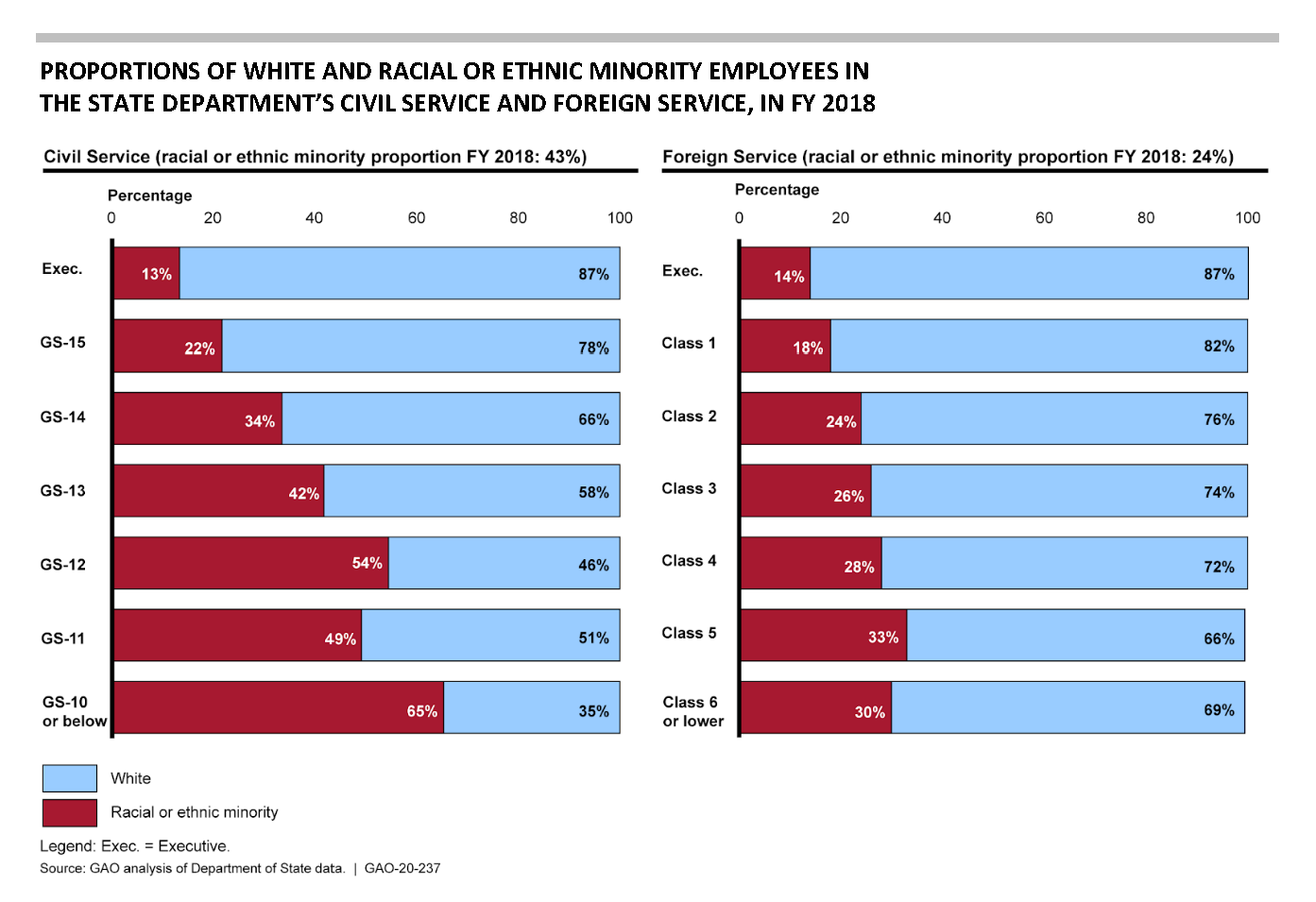
Minority Women Have Struggled to Advance at State and USAID
GAO found that while promotion outcomes (rates and odds) for women and men at both State and USAID were fairly comparable, promotion outcomes for racial or ethnic minorities—both men and women—were often lower than for their white colleagues, especially in the Civil Service. Similarly, the promotion outcomes for white women were similar or even higher than for white men, but the odds of promotion for women of color were often lower. This was true even after GAO controlled for factors, like tenure and occupation, that might affect promotion outcomes. 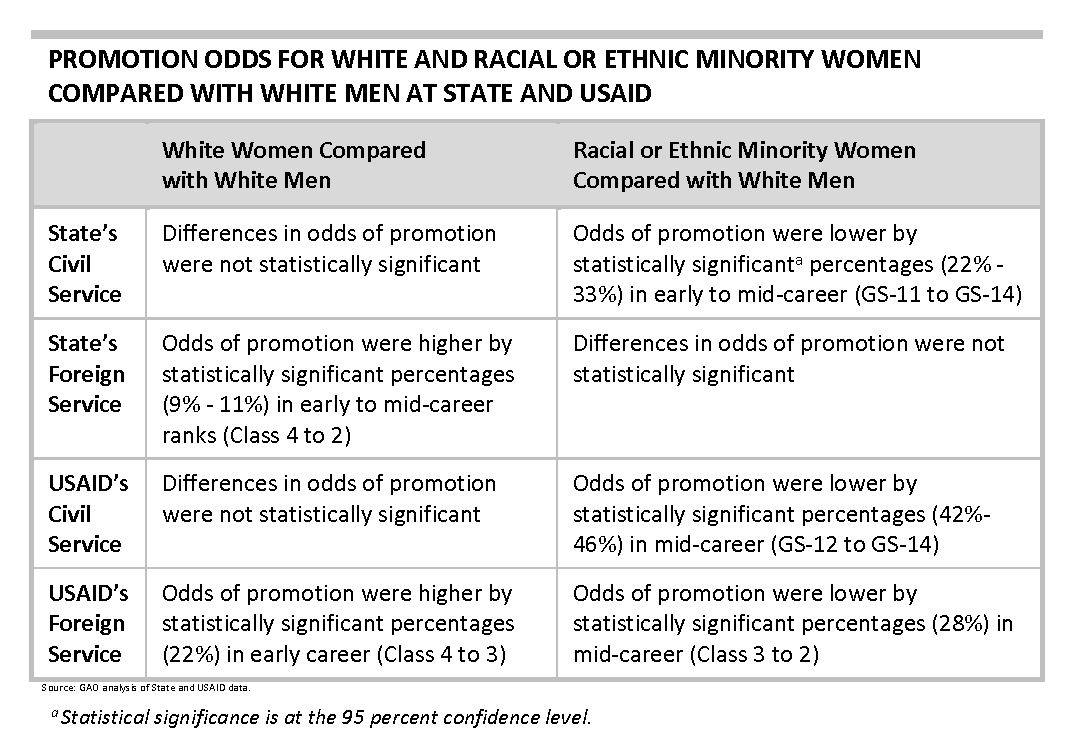
Next Steps: Finding and Addressing the Barriers
Both studies clearly demonstrate that racial or ethnic minority women have lower promotion outcomes, but more study is needed to explore the reasons for systematic differences in the distribution of the genders and racial or ethnic groups within occupational categories. In addition to analyzing data, it will also be important to look at workplace culture and inclusivity, which may impact whether minority women apply for promotions.
Read more GAO findings and recommendations:
Written by Moon Parks, Nisha Rai, Deirdre Sutula, Mona Sehgal and Reid Lowe, US Government Accountability Office
Return to top
 
COVID-19 is changing the foreign policy landscape we thought we were entering, bringing even the strongest countries to a halt. No nation has been immune to its effects and no citizen has not felt its impact. Foreign policy and relationship building will no doubt look very different as the world moves on from the effects of the pandemic. The success of the field will lie in the hands of young professionals like ourselves, who are eager to apply our educational theory into practice.
As second-year international affairs graduate students, we were fortunate enough to work with the Department of State’s Office of International Visitors to write an in-depth paper on the impact of the International Visitor Leadership Program to amplify U.S. public diplomacy across the globe. The onset of the pandemic threw a curveball into our analysis and our traditional concepts of affecting change in the field. Our recommendations for the future of the program were largely predicated on the assumption that at some point the world would get back to ‘normal’. But we also took into account the long-term effects of our new virtual reality and the innovative ways these platforms can reshape and supplement in-person citizen diplomacy. Our hope is that our recommendations can be applied broadly to other U.S. international exchange programs as they look for ways to modernize and combat growing global tensions.
The unpredictability of the pandemic has mirrored the unpredictability of international relations, lending a unique perspective to those making the leap from student to professional. Although we spent two years studying international affairs and foreign policy as concepts, the state of the world has changed. As young professionals, we don’t see the pandemic as an obstacle to diplomacy. We see the opportunities to develop new strategies for global engagement and a reimagined approach to people-to-people diplomacy.
It’s easy to minimize the focus of our role in the global community in favor of our domestic challenges, but domestic and foreign affairs are not mutually exclusive. The ability of exchanges to increase the resiliency of the average global citizen and the ability of virtual components to foster the engagement of a wider audience are clearer than ever before. The world is paying attention, and as recent graduates we are optimistic about the opportunities to reimagine people-to-people diplomacy. By doing this, the U.S. can capitalize on new ideas for the future of foreign affairs and a stronger network of global citizens.
Kelsey Jackson and Rachel Pastor are recent graduates of The George Washington University’s Elliott School of International Affairs with a Master of Arts in International Affairs. Rachel also currently works at the World Affairs Councils of America. A full version of their capstone paper is available upon request (email Kelsey or Rachel), and an adapted version has been submitted for publication.
The International Visitor Leadership Program is celebrating its 80th anniversary with a digital campaign in 2020. Join us on October 29th for a discussion designed to provide international relations students, interns, and foreign affairs professionals with an in-depth understanding of the role of exchange programs, such as the International Visitor Leadership Program (IVLP), in global power dynamics. Registration will open after Labor Day and a link will be shared on eca.state.gov/facesofexchange and the WFPG websites.
Follow the campaign at eca.state.gov/facesofexchange or #FacesOfExchange
Return to top
 
This year amid a global pandemic, all of the important days we typically mark throughout the year—honoring significant milestones, causes, issues, individuals, and more—have taken on new meaning. And the way we commemorate the passing of these days has entirely transformed. As an advocate for refugees and other forcibly displaced people, one such day comes this Saturday, June 20: World Refugee Day. As the spread of COVID-19 threatens to have devastating effects on refugees and other forcibly displaced people this year, including refugee women and girls, how we mark it will be more important than ever.
World Refugee Day was instituted in 2000 to raise awareness of the situation of refugees and “to communicate with the world about who refugees are and why they require protection,” But amid so many new and overlapping global crises, World Refugee Day feels different this year and yet consistent. Consistent in the sense that refugees and other forcibly displaced people continue to face the same challenges year after year. However, this year the pandemic and associated measures to control its spread are exacerbating these existing challenges and bringing them to the fore.
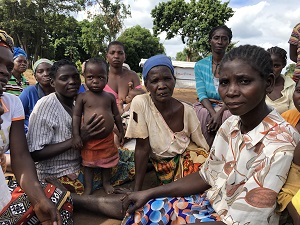 Displaced persons—including refugees, asylum seekers, internally displaced people (IDPs), and stateless people—often live in conditions that are unacceptable. They often face acute risks to their safety, live in cramped quarters, have limited access to health and social services, experience high levels of gender-based violence, face restrictions on movement, and enjoy only limited access to livelihoods. Even before a worldwide health emergency, these factors all add up to create remarkably difficult and uncertain lives for so many refugees. Combined with the continued deterioration around norms and international protection guarantees for those fleeing persecution, refugees have become one of the most vulnerable groups in our global society. Displaced persons—including refugees, asylum seekers, internally displaced people (IDPs), and stateless people—often live in conditions that are unacceptable. They often face acute risks to their safety, live in cramped quarters, have limited access to health and social services, experience high levels of gender-based violence, face restrictions on movement, and enjoy only limited access to livelihoods. Even before a worldwide health emergency, these factors all add up to create remarkably difficult and uncertain lives for so many refugees. Combined with the continued deterioration around norms and international protection guarantees for those fleeing persecution, refugees have become one of the most vulnerable groups in our global society.
In particular, refugee women and girls are bearing the biggest burden of the pandemic. Forced displacement uniquely and disproportionately affects women and girls. The spread of COVID-19 is intensifying their challenges. For refugee women who work, most participate in the informal economy and have lost their livelihoods. School closures have forced millions of girls out of school, and they are much less likely to re-enroll than boys. Access to healthcare, which has always been an issue for refugees, is especially problematic for women and girls as there is a risk of a diversion of resources from women’s specific healthcare such as sexual and reproductive health services to coronavirus-related initiatives and treatment. And finally, as governments have required residents to self-quarantine and lockdown at home, we have seen a dramatic spike of intimate partner violence (IPV). This is true within refugee communities as well. United Nation Secretary General Antonio Guterres even commented on this trend urging all governments to put women’s safety first as they respond to this pandemic.
So how does one commemorate June 20, 2020 in a productive and positive way? How do we recognize a day that highlights a group of people that is so consistently marginalized? First, it is important to learn about the challenges refugees face and how those challenges differ in severity depending on national and local policies. Second, we must challenge those policies. And third, we should seek out refugees’ valuable capabilities and provide space and opportunities for those capabilities to grow.
World Refugee Day 2020 is unique in that there are more refugees today than at any time in recorded history. At the same time there is a global pandemic, and countries have quickly closed their borders, cutting off the prospect of safety for people who need it most. However, let’s also make this year unique in that we improve longstanding challenges that refugees face. None of the solutions are easy, but the time to make headway is now.
Devon Cone,Senior Advocate for Women and Girls at Refugees International, focuses on the unique challenges of forcibly displaced women and girls worldwide and policy recommendations to alleviate those challenges. Previously, she was the Director of Protection Programs at HIAS and a UNHCR Resettlement Officer. @devoncone
Return to top
 
Despite the potential for competent diversity to greatly contribute to the mission and goals of the national security apparatus, the truth of the matter is that we continue to experience challenges in achieving diversity within our ranks. Further, because there is very little research on why the representation of women and underrepresented groups has lagged so significantly, we have a noticeable gap in our understanding and in the data necessary to drive change.
To address this gap and endeavor to accelerate progress on relevant policy and programming, Guidehouse and #NatSecGirlSquad embarked on a study on the barriers to achieving diversity in national security. To be clear, our effort was an exploratory study, designed to “clear the underbrush”—and enhance and accelerate the conversation around challenges faced by women and underrepresented groups in entering and working in this space. While many of us within the field have anecdotal evidence on what those challenges are, this study was an effort to amplify our understanding and add qualitative data to the conversation.
The survey was designed in coordination with an academic researcher from the University of Alabama at Birmingham, Dr. Natalie Todak, whose research focuses on women in policing. The survey was approved by the UAB Institutional Review Board, and was deployed via Qualtrics. The survey link was distributed to the #NatSecGirlSquad listserve, via email, and was posted on the professional social media pages of our project team, to include the pages for Guidehouse and #NatSecGirlSquad.
Recruitment and data collection for the survey were carried out over two weeks in the fall of 2019. 841 people began the survey, and 611 reached the end of the survey. The survey was completely anonymous; however, some demographic information was captured. A brief snapshot of demographics is included below:
-
77% of respondents identified as women
-
70% were in the age range of 25-44
-
83% identified as white
-
This was a highly educated group—64% have a masters degree
-
58% currently work in national security
Full demographic breakouts are available in the final report. We do want to recognize that our sample isn’t as diverse as we had hoped it would be. We recognize that this is an issue, both with our research, and in the field, and that it itself may provide another data point that there is additional work to be done around racial and ethnic diversity.
The data was analyzed and collated into our final report, “What It Looks Like vs. What It Is: Building Competent Diversity in National Security”. The report is organized into three broad categories, capturing respondents’ perceptions and insights into: applying for jobs in national security; working in national security; and leadership and promotion in national security. Some key findings from the report are summarized below:
- 56% of respondents do not consider the national security field to be welcoming to women and underrepresented groups.
- 90% of respondents indicated they wish there were more opportunities made available to assist women and people from other underrepresented groups who are working in this field.
- Almost half—47%—of respondents strongly agreed or agreed that they had experienced discrimination in their role as a leader. When filtered by gender, 59% of women agreed with the statement, while only 16% of men agreed.
- 54% of women strongly agreed or agreed that they had to work twice as hard to earn their position compared to others, whereas 12% of men strongly agreed or agreed with the statement.
It is our hope that this initial survey will not only provide further context for one of the most significant national security challenges of our time, but also enable and support ongoing work to address it and encourage greater collaboration going forward. Moving the needle on diversity will require continued conversation and collaboration, as well as additional research and programming within the government, and across the rest of the national security apparatus.
In order to view the full report, as well as our Resource Center containing additional commentary on the report from key executives within the national security field, please visit the Guidehouse website here.
Cara McFadden is the Partner responsible for the Department of State account within Guidehouse’s National Security Segment.
Return to top
 
Leadership has never been more important than now. As the coronavirus pandemic rages through our communities, our communities are desperate for remedies and relief. We have turned to the body that can deliver both on a large scale — government. Whether at the local level or on the national stage, public leaders have been anointed our guardians, our protectors. Not all have emerged as such.
Long before COVID-19, democracy has been under siege. I've lamented in Interruptrr Weekly about the dwindling power of the people in Turkey, Hungary, Russia, Poland, the Philippines and Brazil. The current global health crisis, with its lockdowns, shelter-in-place orders, border restrictions, and increased surveillance, has turned otherwise strongman tactics into much needed survival mechanisms.
And, still, strongman tactics haven't proven to help survival, now or later. In China, surveillance has become more handy for pinpointing critics rather than the coronavirus. Information control over constructive contribution. In Israel, Benjamin Netanyahu has also embraced surveillance — and used the global pandemic to delay a court inquiry into corruption charges against him. How convenient. In Turkey, Erdoğan's strongman tactics are no longer sufficient to fool the people.
There are bright spots, however. Looking to Germany, New Zealand, and Denmark, the leaders of these countries — who happen to be women — have responded to the coronavirus with soberness. German Chancellor Angela Merkel has spoken as a leader should. New Zealand's Prime Minister Jacinda Ardern has focused on those "Kiwis," as New Zealanders call themselves, abroad, particularly in Australia who are in need of job assistance. And Denmark, Mette Frederiksen has expressed caution, while getting busy on fighting the virus and also focusing on the welfare of Danish citizens.
Good or bad, the post-COVID-19 world will certainly be one in which leadership will be tested. We'll no doubt see the strongmen proclaim that they are "in charge" — and that, we the people, are not the boss of them. We'll also see leaders get on with business in the name of the people. You can bet I'll be watching that.
This article originally appeared in Foreign Policy Interrupted's Interruptrr Weekly, a newsletter which highlights op-eds, research, and expertise by women (subscribe here).
Elmira Bayrasli is Foreign Policy Interrupted's CEO, writes about global entrepreneurs for Forbes, and is the Director of Bard College's Globalization and International Affairs Program. @endeavoringE
Return to top
 
Increasing movement restrictions. Healthcare workers exercising ‘wartime triage’. Bare store shelves and the shuttering of businesses. For those of us living in the United States and other wealthy countries, the COVID-19 pandemic has brought to bear a series of social and economic shocks our governments—and many of us—are struggling to manage. Yet for many of the 71 million people living as refugees, asylum seekers, or ‘internally displaced’ within their own countries, these conditions are not new. The impact of the COVID-19 pandemic in already-fragile settings such as Syria, Afghanistan or South Sudan is potentially devastating. Responding requires informed, as well as inclusive, action. How can we learn from past infectious disease outbreaks in conflict and disaster-affected settings? And how can we ensure, unlike past outbreaks, women and girls are not lost in the response?
While not rising to the level of a pandemic, Cholera outbreaks in Yemen, Syria, and Haiti, and Ebola in Sierra Leone, Liberia, Guinea, and DR Congo, brought numerous direct and knock-on effects. Health systems already weakened by crisis—or even under deliberate attack—were further strained; increased need for clean water and sanitation outstripped supply in environmentally-precarious areas; loss of livelihoods placed further pressure on weakened markets and food-insecure households; and aid was sometimes re-directed to ‘more urgent’ needs. The scale of the current pandemic has already led to border closures and changed migration policies that have significantly affected resettlement processes as well as safe passage for people seeking asylum or migrating for economic or climate reasons.
Recognizing the possible impact of Covid-19 on the world’s most vulnerable—people forced to flee war or still living in it, who lack access to soap and water, or to a hospital bed should they fall critically ill—the United Nations just launched a $2 billion global humanitarian response plan. “If we leave coronavirus to spread freely in these places, we would be placing millions at high risk, whole regions will be tipped into chaos and the virus will have the opportunity to circle back around the globe,” said Under-Secretary-General for Humanitarian Affairs Mark Lowcock.
While devastating to all, there is a growing recognition of the gendered nature of infectious disease outbreaks in crisis-affected settings. These range from increased risk of domestic violence due to household stressors and quarantine measures, to growing care burdens often falling on women, and risks to female health workers on the front line. Covid-19 will be no different.
The 2013-16 Ebola outbreak made increasingly visible the toll of infectious disease on West African women and girls’ lives. Gender-based violence (GBV), which already disproportionately affects women and girls, was exacerbated by increased household stressors, family separation, quarantine measures and school closures. A qualitative assessment by the UN Development Programme found increases in both intimate partner violence and sexual violence in Ebola-affected Sierra Leone when comparing 2014 to previous years, with reports mirroring the curve of the outbreak: as the response to Ebola ramped up, the authors note that reported cases dropped, likely due to crowding out of safe places and pathways for accessing GBV services. As Ebola cases started to stabilize in parts of the country, reports in those locations rose once more. Informal and formal support structures, already strained by conflict or disaster, often face further deterioration in public health emergencies. In Syria and Yemen, the cholera response exacerbated negative ‘coping mechanisms’ such as forced/child marriage, which further links to IPV. The mental health of survivors as well as those who care for them can also impacted.
This type of service-based data speaks to the fundamental need for flexibility and continued funding during public health emergencies, so that vital sexual and reproductive health and rights (SRHR) and GBV services for women and girls can adapt and continue. An IRC assessment showed that, during the Ebola outbreak in Sierra Leone, in areas where funding and flexibility allowed for GBV services to remain open, utilization rates increased by almost 20% at the height of the crisis in comparison to pre-crisis levels. Another study of Sierra Leone from 2014-15 estimates an additional 3,600 deaths occurred due to decreased use of SRH services such as family planning, ante/post-natal care and deliveries in health facilities. It is promising to see this research oft-cited in some of the early and excellent COVID-19 guidance—and it should lead to informed action such as ensuring the Minimum Initial Services Package (MISP), a set of agreed upon, life-saving practices to address SRH needs in emergencies, is prioritized from the outset.
Sexual exploitation and abuse (SEA) by aid workers remains a concern during public health crises. During the Ebola response, a range of actors took advantage of women and girls—including taxi drivers, burial teams, and even vaccinators, who chose to exploit existing power differentials that had been further deepened by the outbreak. My own participatory action, feminist research examines the same dynamics in relation to aid distributions, by working with women and girls living as refugees in Uganda and Lebanon to understand how SEA manifests in relation to accessing food, water, shelter, fuel and firewood, and cash assistance. They identify protective strategies for mitigating SEA risk already in use by women and girls, and recommend specific actions aid actors should take.
These protective strategies to mitigate SEA risk—such as moving in groups and ensuring adequate female aid staff—become increasingly difficult given COVID-19 distancing practices that impact the ways in which women’s groups and aid programs function. For example, women workers may face pressure to stay home and care for others if their own families are impacted, potentially leaving a staffing gap. The emphasis on handwashing and increased need to gather water, usually a gendered activity, may further put women and children at risk in displacement contexts where accessing hygiene facilities is often accompanied by fear of harassment and assault. Adolescent girls, unaccompanied/separated children, the elderly and those living with disabilities may face increased risks given potential shortages of aid and/or increased difficulties in accessing it due to containment measures. At the same time, existing barriers to seeking help may increase. Support to adapt a minimum standard of services that can continue to be safely offered is crucial. Given recommendations around remote services delivered via mobile phone or messaging apps, women and girls’ access to technology has never been more urgent.
Much of the work to make the gendered impacts of disease outbreaks more visible has been done by women and girls themselves—as members of community groups, local activists, human rights defenders, and feminist researchers applying an intersectional and gendered analysis in documenting the extent of the crises that affect them. Their voices, and participation in decision-making and planning, must be centered both in immediate response—where the ‘localization’ agenda can be harnessed to better support women on the frontlines—as well as within longer-term preparedness efforts. Duty of care for staff, and shared assessments of how remote management strategies may displace risk onto the most vulnerable actors, are important considerations for responding responsibly.
Lasting peace and security in fragile settings is achievable when women and girls are included at the table. This is no less true when layered against a global pandemic that threatens the very connectedness by which their societies and families are held together. Communities who have been living in crisis for some time now have much to teach us about adaptation, resilience, and mobilization—if we know how to ask, and how to listen.
This article originally appeared on The Global Women's Institute at the George Washington University blog in partnership with the Georgetown Institute for Women, Peace and Security. Photo Credit: Christopher Penler / Shutterstock
Alina Potts Alina Potts, MPH is a research scientist focused on gender, violence and humanitarian assistance at George Washington University’s Global Women’s Institute.
Return to top
 
When the United States and China reached a Phase One trade agreement in January, US companies with business in China breathed a measured sigh of relief. The agreement was hardly comprehensive, but it broke new ground in resolving old disputes. It also offered a chance at improved commercial and diplomatic engagement after many months of escalating tariffs and tension. But on the heels of the Phase One deal’s announcement, China’s coronavirus outbreak became an epidemic, bringing with it dramatic economic disruptions. COVID-19 has supplanted the trade truce as the relationship’s new destabilizing factor, one that is being leveraged more baldly and aggressively to pry our economies apart.
A popular cause for alarm over US-China trade right now is the specter of overdependence on China for any number of goods that we need and don’t have enough of—from N95 masks and medical gloves to ventilators and hand sanitizer. In fact, as numerous experts have noted, China’s own COVID- 19 response included a ramp-up in production of critical supplies it now has in surplus. Exporting some of this surplus to the United States would aid its own economic recovery and offers a near-immediate solution to some of the shortages we face. Yet many of these items remain subject to trade war tariffs that the US government continues to apply to roughly two-thirds of all imports from China. Scores of business associations signed onto a letter last week asking the president to suspend all China tariffs as an emergency economic measure, but so far, the administration has rejected this idea in favor of narrower tariff exemptions that require time-consuming reviews of formal submissions from companies.
The Defense Production Act invoked last week by the White House allows the government to jump to the front of the line to procure needed supplies from US companies, but it does nothing to facilitate sourcing of supplies from outside the United States. In fact, some officials in the White House and on the Hill would rather focus on obviating any need for imports, pushing legislation that would forbid federal sourcing of some critical items from China, and advocating for Buy America provisions that would require federal agencies to procure essential pharmaceutical ingredients, raw materials, medical equipment, and supplies here at home.
Despite the economic pressures China has faced, and skepticism of its ability to follow through with its Phase One commitments, China has yet to invoke the disaster clause in the agreement or otherwise formally request that the US relax the deal’s terms. Administration officials generally acknowledge that China has kept to a pretty tight schedule in meeting its obligations so far. Ensuring that the terms of the deal are fully implemented will require continuous government and private sector attention and engagement, but China’s resolve to date is the kind of show of good faith that can be built upon. Even so, in the last week, the rumble of rhetorical support for deeper disengagement from China has started to sound like a roar.
Irrespective of political discord, US companies with China operations were quick to contribute millions in aid to Chinese relief efforts last month, and offers of assistance from China have likewise been quick to materialize in our own hour of need. Last week, Chinese billionaire and Alibaba founder Jack Ma sent a million masks and half a million test kits to the United States Centers for Disease Control.
Pushing pause on tariffs and proactively pursuing sourcing opportunities with China offers the United States a smoother path through this crisis and a chance at a faster recovery. Steady progress toward full implementation of the Phase One deal and success restoring US companies’ China operations to profitability offer medium-and-long-term support weathering and recovering from the damage we are sustaining domestically. The United States and China are and will remain strategic competitors, but with so many lives and livelihoods under threat from a common enemy, offers and opportunities to work together should be honored as morally imperative and embraced as additional buttresses for the more stable and reciprocal relationship that both nations need now more than ever before.
Anna Ashton, senior director of government affairs at the US-China Business Council, has previously served as a China analyst for the Department of Defense, US Chamber of Commerce, and US-China Economic and Security Review Commission.
Return to top
 
More than 40 new infectious diseases have emerged since the 1960s, but until the recent coronavirus pandemic, many nations had amnesia about the devastating impact of these outbreaks. As of March 23rd, over 353,692 people globally have been infected with more than 15,430 deaths. In America, more than 35,241 cases of COVID-19 have been reported with over 400 deaths thus far. On Monday, the World Health Organization reported that the pandemic is accelerating globally; it took 67 days to confirm the first hundred thousand cases, 11 days to confirm the second hundred thousand cases and just four days to confirm the third hundred thousand cases. Cases are expected to increase rapidly in the coming weeks.
This life-threatening illness is overwhelming all sectors of society including health care systems with a lack of adequate testing, insufficient personal protection equipment (PPE) for medical providers, not enough hospital beds and a lack of plans in place for schools, businesses, and individuals to effectively respond. Without a vaccine or effective treatments for the disease currently available, we need to take immediate action to follow proven public health practices, like social distancing and personal hygiene, to reverse the curve of this pandemic.
Battling this invisible enemy is very much like fighting a war requiring the mobilization of all sectors of society; each of us must contribute. The choices and decisions we make as individuals and communities now will impact the severity of the outbreak in the weeks and months ahead. An effective response should include the following key components:
Re-establish the White House’s National Security Council Directorate for Global Health Security and Biodefense
The White House should permanently re-establish the National Security Council Directorate for Global Health Security and Biodefense, which was dismantled by the Administration two years ago. With a permanent office dedicated to pandemic and bioterrorism preparedness planning, the federal government would always have senior leadership in place to immediately mount a comprehensive whole-of-government response. Moreover, annual funding for this permanent office would help break the “boom and bust” appropriations cycle that surges when a public health emergency occurs and diminishes when the threat subsides. While it was an important step forward that the White House appointed a Coronavirus Response Coordinator on February 27th within the National Security Council, this appointment came late in the pandemic response trajectory, missing a crucial window for earlier intervention and containment. Although delayed, the government is now mobilizing all federal agencies working with the private sector to contribute their resources to fighting the disease.
How Early Testing Shaped the Pandemic: Lessons Learned from Other Nations
Diagnostic testing at scale is essential to pandemic control with decisions about early testing shaping the course of the pandemic across the world. South Korea significantly slowed its epidemic by utilizing the most expansive and well-organized diagnostic testing systems available combined with extensive efforts to isolate infected people and trace and quarantine their contacts. The country also enacted a key regulatory reform that allowed officials to give near-instantaneous approval to coronavirus testing systems during this public health emergency, so that the country could test more than 10000 people a day.
As the first coronavirus cases were reported in China, within hours Hong Kong moved rapidly to obtain travel and exposure histories from symptomatic patients, and then quickly isolated those individuals. With memories of the devastating national security, economic, and health impacts of the SARS and MERS epidemics, Hong Kong, Taiwan, and Singapore marshaled political and public will, implementing advanced tracking systems and interventions that have kept coronavirus cases and deaths relatively low.
In February, problems with reagents in the CDC’s coronavirus test kit impeded the rapid expansion of screening to state and local public health laboratories in America as did not adopting the WHO’s recipe for the test used in many other countries. Moreover, failing to swiftly navigate the FDA’s Emergency Use Authorization regulations, the government was stalled for about a month before expanding testing capacity to academic centers as well as to public health and commercial labs. On March 16th, the Administration stated that millions of diagnostic tests would become available by the end of that week, but this has not yet occurred. Additionally, the promised website that would show where tests have been conducted and positive cases have been detected across the country has not yet been established.
The United States has now accelerated the FDA approval process, so that high throughput platform testing will become possible. Such testing can process tens of thousands of tests each day, as compared to the hundreds of manual tests that had been conducted until recently. However, most clinicians and commercial testing labs will not administer tests to patients with COVID-19 symptoms in their offices, given the potential for viral spread to health care workers and other patients. For this reason, the US has begun establishing special testing units outside of hospitals and the drive-through testing stations, like those used in South Korea, to expand early detection safely and prevent viral transmission to others. Moving forward, America needs a rapid diagnostic test (one was just approved by the FDA this week), as well as home testing kits that provide results in a matter of minutes rather than days.
In the United States, hospitals are becoming overwhelmed with patients and do not have enough ventilators and personal protection equipment (PPE) for their health providers. Such scarcities put both providers and their patients at risk. In Italy, COVID-19 has seriously overloaded the healthcare system forcing rationing of treatment. These circumstances underscore the crucial importance of supporting the healthcare workforce with the resources and the PPE they need. The United States must take decisive action to prepare its healthcare system before cases reach similar crisis levels. After a call from Congress, the President invoked the Defense Production Act, to scale up production of these lifesaving medical resources. However, although masks and other equipment are now coming from a variety of sources, the President has not used his authorities to require companies to repurpose their factories to manufacture medical supplies at the massive scale needed now by our health care facilities.
Investments in Research Can Bring Lifesaving Dividends
As a result of revolutionary scientific advances, the COVID-19 genome was sequenced in two weeks after the coronavirus was identified as compared to the six months it took for SARS. This facilitated efforts to fast track the development of a vaccine. Pursuing an accelerated timeline, several vaccine candidates at the NIH and in the private sector are under development. In fact, last week a clinical trial began in Seattle of one of these vaccine candidates. However, the results of this study and subsequent production and distribution of this immunization, if proven safe and effective, could still take 12-18 months. Additionally, medications used for treating malaria including chloroquine and other anti-viral drugs such as Remdesivir are currently being evaluated in clinical trials for treatment of COVID-19.
With three serious global coronavirus outbreaks occurring over the past two decades, exploring the feasibility of a universal coronavirus vaccine and establishing a national vaccine production center would be extremely worthwhile investments. Incentives should be provided to support public-private partnerships that help to mitigate the financial risks of developing life-saving vaccines.
Investigating Sex Differences
Emerging data indicates that while there are similar numbers of COVID-19 cases among women and men, more men than women are dying of the disease. This trend has been consistent across many countries severely impacted by the virus, including confirmed cases in China, hospitalized cases in Italy, and confirmed cases in South Korea, where men were 65%, 75%, and 89% respectively more likely to die than women. At this time, it is unclear whether these sex differences are due to biological differences such as hormonal or immunological factors, or behavioral factors such as higher smoking rates among men, a risk factor for severe disease.
As more data is collected about this pandemic, sex-based analyses should be conducted. Gender norms, roles, and behaviors that influence women's and men's differential vulnerability to infection, exposure to pathogens, and treatment received should be considered and addressed. Understanding how pandemics affect females and males differently would be an important step forward in illuminating the effects of a health crisis on individuals and communities and for establishing equitable, effective policies and interventions.
Leverage Technology to Inform and Connect Us
Mobile devices present important platforms for instantaneously sharing information, tracking disease spread in real-time, facilitating professional training and research collaborations across communities and countries. Public health officials must work closely with the media to ensure accurate reporting of outbreaks and counter disinformation that can occur in social media.
Moreover, as individuals across the United States use social distancing and proven public health practices to #FlattenTheCurve, the media, the Internet with resources like coronavirus.gov, and social media can provide important information as well as connectivity that can serve as an antidote to feelings of loneliness and isolation. The MIT Media Lab, in collaboration with Tufts Public Health and other organizations, has launched a creative social media campaign, #BeatTheVirus that is engaging celebrities, athletes, and citizens in implementing the personal actions that can help decrease viral spread.
Health in all Policies
The coronavirus pandemic has significant implications beyond health. Its economic toll must be urgently addressed with increasing unemployment and a plummeting stock market. Congress has passed several bills, including $8.3 billion to ramp up vaccine research, provide funding to state health officials, and boost prevention programs. On March 18th, the Senate approved a $104 billion bill that would provide direct help to Americans with expanded sick and family leave. What is now being negotiated in Congress is $1.8 trillion plus economic stabilization legislation to address the needs of individuals and businesses that have resulted from this devastating pandemic.
Additionally, as schools close their doors indefinitely and move online, approximately 30 million children who rely on the National School Breakfast and Lunch Programs for daily meals risk going hungry. Legislation must address ways to provide nutrition for these children. Moreover, for the five million households with school-age children who have no access to broadband Internet at home, school closures represent more than a temporary inconvenience. That is why the E-Rate should be expanded from public schools and libraries to homes so that children in low-income families can keep learning during this public health crisis.
At the state and local levels, officials are making critical decisions in the battle against the coronavirus pandemic. Absent clear direction from the federal government, ten states including Massachusetts, California, New York, Illinois, Connecticut, New Jersey, Delaware, Louisiana, and Ohio have asked residents to shelter in place. One in three Americans have been told to stay at home amid this pandemic. The federal government should expand its coronavirus response guidelines to adopt consistent recommendations nationwide so that there is clear messaging for everyone. Social distancing and personal hygiene can only be maximally effective if every state and every person puts these practices into action.
Looking to the Future
Not since the 1918 pandemic flu, has there been an infectious disease outbreak that has threatened the health and economy of our country and world with such devastating and rapid impact. Making significant investments now to increase the scientific knowledge base, developing new technologies that can be deployed in combination with proven public health practices, as well as strengthening health systems, businesses and schools with coordinated, permanent public health preparedness plans, will boost our ability to better contain spread of this life-threatening coronavirus outbreak as well as fight other emerging disease threats more swiftly and effectively in the years ahead.
The United States is at a critical inflection point in our pandemic response, reporting cases at the level of Italy two weeks ago. In the coming days and months ahead, the choices we make will shape the trajectory of this pandemic. From the White House in Washington, DC to every other house across America, everyone must play their part to #BeatTheVirus and #FlattenTheCurve. As President Franklin D. Roosevelt said during World War II, together, “we must face the arduous days before us in the warm courage of national unity” if we are to ensure that COVID-19 is a disease found only in history books.
Rear Admiral Susan Blumenthal Markey, MD (ret) is former US Assistant Surgeon General, Senior Fellow in Health Policy at New America, Senior Medical Advisor at amfAR, The Foundation for AIDS Research, and a Clinical Professor at Tufts and Georgetown University Schools of Medicine. She is the Public Health Advisor and co-creator of the #BeatTheVirus campaign. Matina Kakalis is a Research Associate in Health Policy at New America.
Rear Admiral Susan J. Blumenthal, MD (ret) is former U.S. Assistant Surgeon General, Senior Fellow in Health Policy at New America, Senior Medical Advisor at amfAR, The Foundation for AIDS Research, and a Clinical Professor at Tufts and Georgetown University Schools of Medicine. She is the Public Health Advisor and co-creator of the #BeatTheVirus campaign. Matina Kakalis is a Research Associate in Health Policy at New America. susan-blumenthal.org
Return to top
 
As the novel coronavirus (COVID-19) continues to spread around the world, the unfolding economic and public health crises may see China’s neighbors shift their attention back towards Beijing, potentially threatening the United States’ leadership position in the region and its ability to maintain its advantage in strategic competition with Beijing. Kurt Campbell and Rush Doshi recently warned that China is moving quickly to position itself as the global leader of the pandemic response, while the United States is struggling with its efforts to battle the virus at home. As many of the United States’ most important allies and partners rely heavily on China economically, Washington needs to coordinate not only with its allies and partners, but also with China, to fight the global pandemic and minimize its economic impact.
Since the coronavirus was first detected in the city of Wuhan in November 2019, China and its neighboring countries have been hit severely by the outbreak. As the crisis worsened mostly in Asia in January and February of 2020, the international community speculated that the coronavirus would undermine the legitimacy of Chinese leadership, following charges of authoritarian misgovernance by Beijing and a lack of transparency about the virus. Due to the widespread lockdowns across the country, China suffered a supply shock with its factories unable to operate. Its industrial output tumbled 13.5 percent in the first two months of the year, representing the largest contraction on record, and its gross domestic product is estimated to have fallen 13 percent in the first two months of 2020.
When the virus started to spread to neighboring countries, it also disrupted supply chains across the region. Hyundai and Nissan had to temporarily suspend production lines in their factories in South Korea and Japan respectively in February, due to shortages of automobile parts from China. Samsung and SK Hynix, which make 75 percent of the world’s smartphone Dram memory chips, as well as Samsung and LG, which produce 94 percent of high-end global smartphone screens, are likely to be exposed to supply chain disruption through the rest of the year, due to a shortage of raw materials, tighter restrictions in the movement of people, goods, and services, and production line closures.
Although it is too early to know the consequences of coronavirus on the global and regional economy and supply chains fully, some of China’s neighboring countries and their firms were already moving or considering moving production lines to other countries, as well as reviewing their corporate strategies to reduce their dependence on China and their vulnerability to supply chain disruptions. These shifts have also been driven by pre-existing supply chains disruptions in China due to the US-China trade war and potential decoupling.
Since early March, however, the rhetoric has completely changed as China and its neighbors demonstrated their ability to control domestic outbreaks quickly and effectively, while the crisis intensified in the United States, Europe, and around the world. The Chinese Communist Party (CCP), in particular, has shifted its narrative from covering up the accuracy of its data to amplifying reports of the success of its response to pandemic. Although China has yet to return to business as usual, it is likely that China will be the first critical link in reviving the global and regional economy as it begins to restore its supply chains.
With these developments, companies that were trying to reduce their heavy reliance on China cannot help but reverse their moves to keep their supply chains open and operating. It is critical for countries like Japan and South Korea—whose electronics and automotive industries were seriously hit by COVID-19—to promote recovery in their key industries, as their financial markets continue to reel. As soon as China returns to business as usual, it is likely that Beijing will offer diplomatic and economic incentives to restore and boost its trade and investment with its neighboring countries to offset the risks of decoupling from the United States and give itself more leverage in its strategic competition with Washington.
In light of China’s likely campaign, the United States must step up its efforts to coordinate closely and effectively with its allies and partners in the region in order to protect its share of global supply chains. It might be time to re-evaluate its protectionist trade policy and export controls driven by its skepticism in globalization. This approach might have thus far helped the United States gain advantage in its economic competition with China, but these policies have damaged Washington’s relationship with its allies and partners, as well as its standing as a global leader.
Dr. Miyeon Oh, director and senior fellow of the Asia Security Initiative in the Atlantic Council’s Scowcroft Center for Strategy and Security, has significant experience in both academia and working in the public sector with the United Nations and Korea’s Ministry of Foreign Affairs and Trade. This article was originally published by the Atlantic Council.
Return to top
|








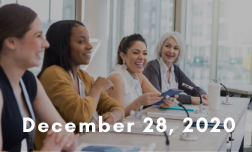
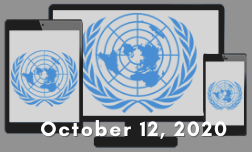
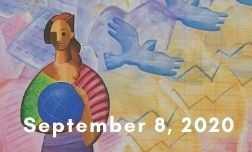
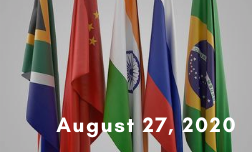
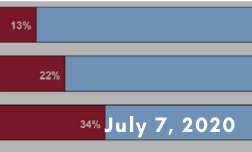
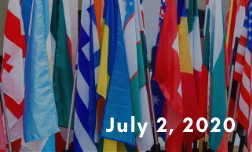
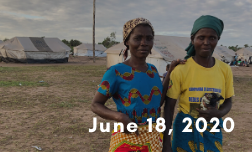

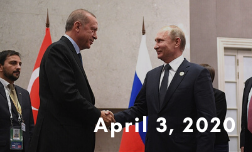
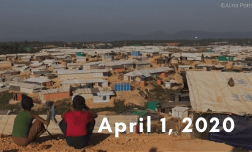
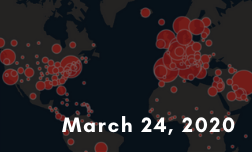

 Twenty-five years ago, I stood in the plenary hall of the United Nations Fourth World Conference on Women in Beijing to hear then First Lady Hillary Rodham Clinton
Twenty-five years ago, I stood in the plenary hall of the United Nations Fourth World Conference on Women in Beijing to hear then First Lady Hillary Rodham Clinton  This was the kind of experience I could only dream about when I took the Foreign Service Exam. The emotion, energy, and determination in that electric moment inspired me and informed my career for years to come.
This was the kind of experience I could only dream about when I took the Foreign Service Exam. The emotion, energy, and determination in that electric moment inspired me and informed my career for years to come. 
 The US commitment to the UN Women’s Conference did not end in Beijing. Some months after returning home from Beijing, I was appointed as the Senior Coordinator for International Women’s Issues, a State Department position supported by Hillary Clinton and Madeleine Albright to encourage follow up to the UN Conference and to integrate women’s issues into US foreign policy. This role grew into the Ambassador-at-Large for Global Women’s Issues when Secretary of State Hillary Clinton appointed
The US commitment to the UN Women’s Conference did not end in Beijing. Some months after returning home from Beijing, I was appointed as the Senior Coordinator for International Women’s Issues, a State Department position supported by Hillary Clinton and Madeleine Albright to encourage follow up to the UN Conference and to integrate women’s issues into US foreign policy. This role grew into the Ambassador-at-Large for Global Women’s Issues when Secretary of State Hillary Clinton appointed 
 We see this intergenerational continuum of women’s leadership from Hillary Clinton’s clarion call at the UN Women’s Conference, to Malala Yousufzai’s defiance of the Taliban, to Greta Thunberg and Vanessa Nakate’s demands for action on climate change. So, wherever you are in your life journey, join in this unstoppable march of progress for women. Take the Foreign Service Exam, or take a leap and get into some other arena, and use your talents to work on big important issues. Bring other talented young women into the arena with you and make space for them when it’s their turn to lead. We still have so far to go.
We see this intergenerational continuum of women’s leadership from Hillary Clinton’s clarion call at the UN Women’s Conference, to Malala Yousufzai’s defiance of the Taliban, to Greta Thunberg and Vanessa Nakate’s demands for action on climate change. So, wherever you are in your life journey, join in this unstoppable march of progress for women. Take the Foreign Service Exam, or take a leap and get into some other arena, and use your talents to work on big important issues. Bring other talented young women into the arena with you and make space for them when it’s their turn to lead. We still have so far to go. 








